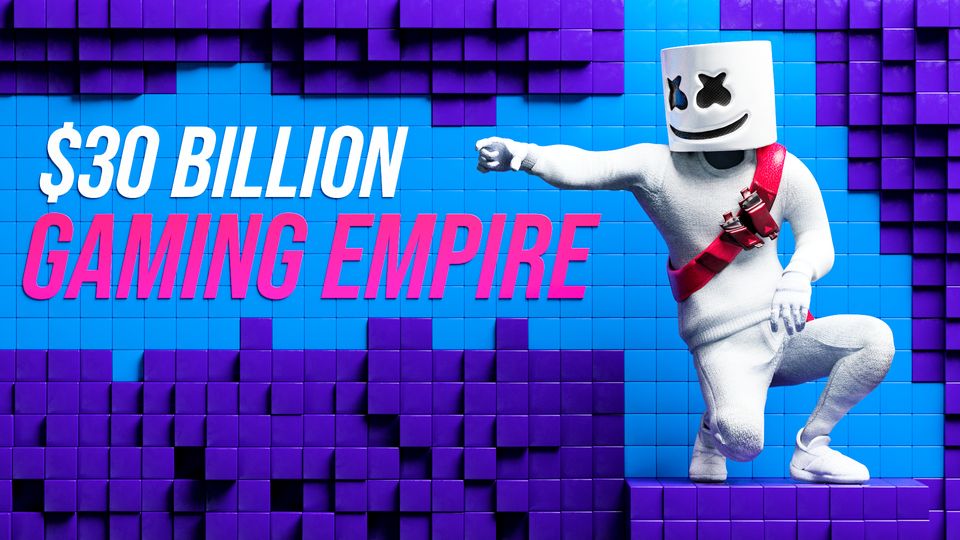Why Epic Games Took 25 Years to Make Fortnite

At first glance, Fortnite might just seem like a typical video game, but what if I told you that it’s actually just one small piece of a $30 billion dollar empire that is set to change gaming forever?
Fortnite is one of the most profitable games ever made. But the company behind the game is just getting started. Epic Games spent nearly 30 years laying the groundwork that would allow them to create the most fun, and most profitable games in the world. Instead of simply making a great game, Epic has built a network of businesses that virtually guarantee continued growth for the company, regardless of what game is most popular at the moment. Tim Sweeney is the founder of Epic Games, and he’s been methodically planning to take over the gaming world for decades now, but you probably don’t know much about him.
That’s because he intentionally keeps a very low profile and is extremely focused on his vision for the future of gaming. Despite being a billionaire, he doesn’t spend time partying on fancy yachts or hanging out with celebrities. He’s on a mission to change the world of gaming and fundamentally alter the way humans interact with each other. His ultimate goal is to create a fully immersive metaverse, like the one seen in Ready Player One, and he’s already on the right track. He’s building all the fundamental infrastructure that will be required to power something like the Oasis and that’s starting to scare big tech companies.
Apple and Epic are battling it out in the courts, but in order to understand what’s really going on here, and why Tim is willing to risk everything in order to take on big tech, we really have to understand Tim as a person and drill into what motivates him. Tim has developed some very unique skills and discovered an incredible business model in the process. His strategy has completely set Epic apart from the competition and is truly one of the most interesting technology stories of the last 30 years.
Tim Sweeney was born in Potomac, Maryland in 1970, and developed a love of computers and engineering at a young age. He’d spend his free time disassembling lawn mowers and playing Atari games, but computers weren’t exactly widely available at that time. Fortunately for Tim, he was lucky enough to be born into a family that had access to cutting edge technology. See, his dad worked at the Department of Defense where his job was to create military maps as part of the Intelligence Unit. This meant that his dad had access to the best computers available at the time and could see first hand the impact technology was going to have on the world. Additionally, Tim had a brother who was 10 years older than him who worked in the computer industry and helped introduce Tim to programming when he was just 11 years old.
When Tim saw the flexibility of his brother’s IBM computers, he was hooked. He was a natural programmer and started dedicating all of his free time to learning about computers. Tim’s brother Steve clearly recognized the raw programming talent Tim possessed, so he purchased an Apple II. Tim immediately started building software for the Apple II, and because his dad was connected to the DOD, Tim was able to access basic internet forums to ask questions about problems he ran into. At that time, the internet was extremely small. You literally had to either work at a major university or for the government to get access. So Tim was lucky to connect with these experts directly.
There are plenty of people with innate programming skills, but that alone isn’t enough to become a successful entrepreneur. You have to understand business and develop an intuition for what your best opportunity is at any given time. Tim started developing his business skills while in high school. He was working a summer job at a hardware store and realized that the only way for him to make more money was to work more hours at the store. So he quit his job and set up a lawn mowing business where he could make five times as much money by setting his own prices and using a tractor to get jobs done faster. This idea of always seeking out the highest leverage opportunity is at the core of most entrepreneurship philosophy: create a system that makes money so that your income no longer requires your direct input.
Tim realized this while still in high school, so when he got to college he was in a prime position to start working on the most scalable business of all: software development. He went to the University of Maryland to study engineering and wasn’t a particularly great student. He spent most of his time working on computers and the only courses he really enjoyed were related to math and physics, which will play a big role later in this story.
He needed to make money while in college, but wanted to build his computer skills at the same time, so he started a company called Potomac Computer Systems. At that time, he hadn’t built a product yet, he was just consulting for small businesses to make sure they had usable computer systems. His new business made enough money to pay for an IBM 286, which was a big step up in terms of computing power. Even though Tim enjoyed programming on the Apple II, more businesses used IBM computers at the time, so that’s where the real money could be made.
At the time, writing software was extremely cumbersome and nearly every business needed custom software to run efficiently. This was before AWS, before GitHub, and even before basic text editors existed like Vim or eMacs, so Tim set out to create a text editor that could speed up software development. But as was building the text editor, he realized that he could build a simple video game using the same tools, so he pivoted and launched a game called ZZT.
In past videos, I’ve talked about how tools like Discord and Slack grew out of failed attempts to make games, and this is kind of the opposite scenario. Tim wanted to create a tool and wound up making a game. And the game did well, at least given how small the PC gaming market was at the time. This was 1991 after all.
Interestingly, the “shareware” distribution model that Tim used to sell ZZT was remarkably similar to what Epic would use to sell Fortnite over 25 years later. He gave the basic version away for free, and then had customers who liked the game pay for extra features. Additionally, the user could edit the game themselves, so anyone who installed ZZT could create their own levels, much like Fortnite Creator Mode, which we’ll get to in a minute.
With ZZT selling well, Tim realized that he should focus on game development and put aside the consulting work he was doing before. So he changed the name of the company to Epic MegaGames. He was still distributing ZZT as “shareware” which meant he had to personally mail physical copies of the game to customers, but, he would keep 100% of the revenue he generated.
Most game developers focus on making their games as good as possible, and then partnering with a publisher like Sony, Microsoft, or Nintendo to actually push their game out to the public. Game publishing was still in its infancy though, and the allure of keeping 100% of the profits for Epic was too good to pass up, so Tim decided to grow his team and publish more games directly to customers.
Even though he was still in college, Tim hired several key people to help him develop his next game, which would be a 2D side-scrolling game called Jill of the Jungle. This game looks extremely simple nowadays, but at the time it was cutting edge. In order to make and sell this game, Tim hired Cliff Bleszinski, who was just 17 years old at the time, and Mark Rein, who had been working at ID software making games like Doom.
When people think of Doom today, they usually think of the 2016 version for Xbox One and PS4, but back in 1993, Doom was released for MS-Dos computers and looks extremely simple now. But Doom was revolutionary at the time, selling millions of copies and introducing the world to 3D video games that could be played on a home computer for the first time. In many ways, Doom was just as big of a cultural moment as Fortnite, completely dominating the conversation about PC gaming for years and inspiring tons of game developers to make their own 3D shooters.
Tim wanted Epic to get in on the action and make a 3D game like Doom, but that wouldn’t be easy. Rendering 3D levels on basic home computing hardware required some really complicated game programming that only ID software had figured out at the time. But Tim saw this as an opportunity. He recognized that anyone who wanted to make a modern video game would need to spend countless hours building the low-level rendering technology to actually get the game to work. All this had to be done before they could create levels or integrate a story or particular game mechanics that gamers would actually care about, so Tim set out to solve this problem for the entire industry.
Epic would focus on developing two pieces of software. The first would be a game called Unreal that would compete directly with Doom, but the second would be a game engine that would allow any game developer to make their own 3D game without needing to do all that low-level programming. This product was called Unreal Engine, and it’s still the core to Epic’s business model today.
Unreal became a popular game soon after launch, but all the marketing and promotion that Tim did around the game really served to attract developers to Unreal Engine. The video game industry was starting to really take off in the late 90s and developers wanted to focus on quickly releasing games without building an entire game engine every time they created a new title. Unreal Engine solved this problem perfectly and went on to power games like Deus Ex, BioShock, and Splinter Cell.
This was a huge win for Tim Sweeney and the entire Epic team, but getting developers to make games with Unreal Engine was just the beginning. They weren’t just speeding up development, they were actually unlocking new markets for game developers.
See, by the mid-2000s, the gaming market had fragmented. Gaming consoles had taken off, but there wasn’t a clear winner. The Playstation and Xbox both had significant market share, and developers wanted everyone to play their games, regardless of what hardware they had. By building their games on top of Unreal Engine, developers could release Playstation, Xbox, and PC versions of their games without much extra work. Epic was making it easier for developers to launch bigger games and make more money, so these developers were happy to pay Epic a small revenue share in exchange for use of Unreal Engine.
But Tim wanted to make sure that Unreal Engine would always be the go-to platform for developing games and there was a new generation of gaming hardware coming out. In 2005, Microsoft was going to release the Xbox 360, and Tim knew that if Epic could create a flagship game that everyone played, it would draw even more developers to the Unreal Engine.
So Epic made Gears of War. And it was huge. This game showcased everything that these next generation consoles could do and highlighted the power of Unreal Engine. Gears of War featured a bunch of new mechanics that were only possible because so much of the heavy lifting was done by Epic’s new Unreal Engine 3. Major franchises like Borderlands and Mass Effect used this new version to sell millions of games and win dozens of awards.
With Unreal Engine growing relentlessly, Tim decided to take outside investment for the first time in Epic’s history. In 2012, he sold 40% of his company to Tencent for $330 million dollars. This new capital allowed Tim to refocus Epic on what really mattered for long-term growth. Epic sold Gears of War to Microsoft and doubled down on Unreal Engine.
Tim’s vision for Unreal Engine expanded to meet the needs of all modern developers. A game engine that only helped with rendering and game interactions wasn’t enough anymore. Increasingly, games were played online, integrated with payment processors, and needed distribution. So Epic would expand to offer all of that, all for the low price of just a 5% royalty.
But $330 million dollars is a lot of money, and it’s natural for any company that gets a huge cash influx like that to want to expand even further, so Epic planned out a slew of new games. First, they started working on a new Unreal Tournament game, but they also wanted to compete with League of Legends, so they built a game called Paragon to get into the multiplayer online battleground space. Minecraft had also recently become very popular, which motivated Epic to release a game that merged building mechanics with tower defense. They called that game Fortnite, but at this point the game didn’t look anything like the Fortnite that’s popular now.
But in 2017 everything changed for Epic. All three of those games got stuck in development and couldn’t really find a strong audience. There were small beta tests, but nothing really caught on. But then PlayerUnknown’s Battlegrounds came out and it was a huge hit. The general idea of a battle royale had been around for a while, but PUBG was the first game to really bring the concept into the mainstream.
With Unreal Tournament, Paragon, and Fortnite all struggling, Tim decided to pivot the company to focus on battle royale. So the Unreal Tournament team took what the Fortnite team had built so far and started making an online battle royale mode for the game. They sprinted hard to get Fortnite Battle Royale out into the world, and they released it in September of 2017, just 6 months after PUBG was released. The game was a massive success and got 10 million active players within just 2 weeks.
There are a few key reasons why Fortnite was so successful and they all built upon the work Tim had done at Epic over the previous 25 years. First, Fortnite was immediately cross-platform, which was only possible because of all the resources Epic had poured into making Unreal Engine platform independent from day one. Second, Fortnite was far less buggy than the competition. Since the Epic team knew the Unreal Engine codebase inside and out, they were able to make sure that the game could run reliably without issues on all kinds of devices, even older PCs. PUBG is actually built on Unreal Engine as well, but their team didn’t have the resources or experience to utilize the engine to its full potential. Lastly, Fortnite was free-to-play, which has been Tim’s go to business model since he released his first game ever. Epic had an entire team internally dedicated to online services to help with things like scaling servers and offering micro-transactions. Even though they didn’t charge for Fortnite up-front, Epic still made more than $9 billion dollars in its first two years. Incredible.
But Fortnite is just one game, and Tim has seen gamers can move from one trend to another really quickly before. The Gears of War sequels were never as profitable as the first game, and betting all of Epic on Fortnite staying popular was simply too risky. So he focused on further diversification.
Since millions of people had already installed Fortnite, he made the decision to convert the Fortnite launcher into a store where you could buy all sorts of games. Valve’s Steam platform has been the dominant PC game distributor for years, but they take a 30% cut of revenue from game developers. Epic majorly undercut Valve, charging just 12%, which was a huge incentive to start selling on the Epic Games Store.
These royalty fees are a big point of contention in many parts of Epic’s business now. Recently, they have been trying to get around Apple’s 30% in-app purchase fee by allowing customers to pay with credit cards directly, instead of going through Apple. This violates the App Store policies and has led to a massive lawsuit between Apple and Epic Games, which is still going on as of June 2021.
It’s easy to cynically look at this battle between two tech companies worth billions of dollars and assume that they each just want to make more money, and that’s not entirely wrong. But Tim Sweeney does have a very specific vision for Epic’s future that benefits from an open internet with low interchange fees. See, Tim wants to create a metaverse. He wants Fortnite players to be able to take the content they’ve purchased into Minecraft and vice versa, but that’s just the start.
Increasingly, Fortnite isn’t just about competition, it’s become a place to hang out and socialize, build things with your friends, and see concerts. As these games become more immersive, they start to behave more like social networks than traditional single-player games. Tim thinks that the future of human interaction will take place in a virtual space powered by Unreal Engine. Simply put, being beholden to Apple or Google will make it significantly harder to scale as quickly as he would like.
Tim has been working on Epic for 30 years now and he’s in some ways just beginning his journey. The company has expanded significantly with four key business lines built around Unreal Engine. Fortnite brings in money directly and serves as the perfect showcase for what’s possible with Unreal Engine. Epic Online Services helps new multiplayer games scale when they start growing and need more servers. The Epic Games Store now lets Epic distribute not only their new games, but also games from other publishers. And Epic also has their own studio and publisher for building and releasing new games.
This flywheel is incredibly powerful, because all of the business lines feed into one another. Epic can use profits from Fortnite to help grow their Game Store and then use profits from the Game Store to develop new games. The experience they get from building Fortnite informs how they think about the next version of Unreal Engine and so on. It’s a virtuous cycle that helps keep the company growing indefinitely. And that’s awesome.
If you want to chat about startups, just DM me on Twitter.
This post is also available as a YouTube video, check it out:




